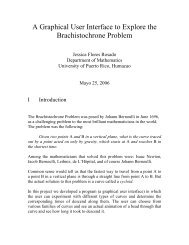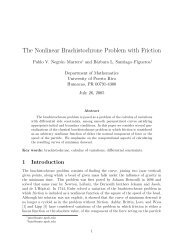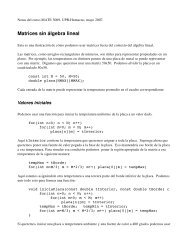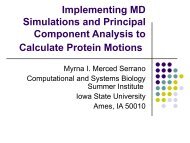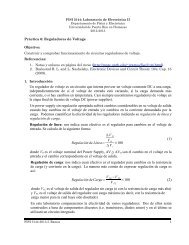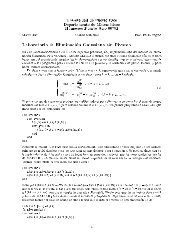- Page 1 and 2: A Probability Course for the Actuar
- Page 3 and 4: Contents Preface 7 Risk Management
- Page 5 and 6: CONTENTS 5 40 The Central Limit The
- Page 7 and 8: Preface The present manuscript is d
- Page 9 and 10: RISK MANAGEMENT CONCEPTS 9 Two vari
- Page 11 and 12: Basic Operations on Sets The axioma
- Page 13 and 14: 1 BASIC DEFINITIONS 13 Example 1.3
- Page 15 and 16: 1 BASIC DEFINITIONS 15 Let A and B
- Page 17: 1 BASIC DEFINITIONS 17 Problems Pro
- Page 21 and 22: 2 SET OPERATIONS 21 (g) A ∪ (A c
- Page 23 and 24: 2 SET OPERATIONS 23 Given the sets
- Page 25 and 26: 2 SET OPERATIONS 25 Example 2.11 Fi
- Page 27 and 28: 2 SET OPERATIONS 27 Proof. Suppose
- Page 29 and 30: 2 SET OPERATIONS 29 Of these policy
- Page 31 and 32: 2 SET OPERATIONS 31 Problem 2.15
- Page 33 and 34: Counting and Combinatorics The majo
- Page 35 and 36: 3 THE FUNDAMENTAL PRINCIPLE OF COUN
- Page 37 and 38: 3 THE FUNDAMENTAL PRINCIPLE OF COUN
- Page 39 and 40: 4 PERMUTATIONS AND COMBINATIONS 39
- Page 41 and 42: 4 PERMUTATIONS AND COMBINATIONS 41
- Page 43 and 44: 4 PERMUTATIONS AND COMBINATIONS 43
- Page 45 and 46: 4 PERMUTATIONS AND COMBINATIONS 45
- Page 47 and 48: 4 PERMUTATIONS AND COMBINATIONS 47
- Page 49 and 50: 5 PERMUTATIONS AND COMBINATIONS WIT
- Page 51 and 52: 5 PERMUTATIONS AND COMBINATIONS WIT
- Page 53 and 54: 5 PERMUTATIONS AND COMBINATIONS WIT
- Page 55 and 56: 5 PERMUTATIONS AND COMBINATIONS WIT
- Page 57 and 58: 5 PERMUTATIONS AND COMBINATIONS WIT
- Page 59 and 60: Probability: Definitions and Proper
- Page 61 and 62: 6 BASIC DEFINITIONS AND AXIOMS OF P
- Page 63 and 64: 6 BASIC DEFINITIONS AND AXIOMS OF P
- Page 65 and 66: 6 BASIC DEFINITIONS AND AXIOMS OF P
- Page 67 and 68: 7 PROPERTIES OF PROBABILITY 67 7 Pr
- Page 69 and 70:
7 PROPERTIES OF PROBABILITY 69 Sinc
- Page 71 and 72:
7 PROPERTIES OF PROBABILITY 71 Proo
- Page 73 and 74:
7 PROPERTIES OF PROBABILITY 73 Prob
- Page 75 and 76:
8 PROBABILITY AND COUNTING TECHNIQU
- Page 77 and 78:
8 PROBABILITY AND COUNTING TECHNIQU
- Page 79 and 80:
8 PROBABILITY AND COUNTING TECHNIQU
- Page 81 and 82:
Conditional Probability and Indepen
- Page 83 and 84:
9 CONDITIONAL PROBABILITIES 83 Proo
- Page 85 and 86:
9 CONDITIONAL PROBABILITIES 85 Prob
- Page 87 and 88:
9 CONDITIONAL PROBABILITIES 87 Prob
- Page 89 and 90:
10 POSTERIOR PROBABILITIES: BAYES
- Page 91 and 92:
10 POSTERIOR PROBABILITIES: BAYES
- Page 93 and 94:
10 POSTERIOR PROBABILITIES: BAYES
- Page 95 and 96:
10 POSTERIOR PROBABILITIES: BAYES
- Page 97 and 98:
10 POSTERIOR PROBABILITIES: BAYES
- Page 99 and 100:
10 POSTERIOR PROBABILITIES: BAYES
- Page 101 and 102:
11 INDEPENDENT EVENTS 101 Example 1
- Page 103 and 104:
11 INDEPENDENT EVENTS 103 then by T
- Page 105 and 106:
11 INDEPENDENT EVENTS 105 Solution.
- Page 107 and 108:
11 INDEPENDENT EVENTS 107 independe
- Page 109 and 110:
12 ODDS AND CONDITIONAL PROBABILITY
- Page 111 and 112:
12 ODDS AND CONDITIONAL PROBABILITY
- Page 113 and 114:
Discrete Random Variables This chap
- Page 115 and 116:
13 RANDOM VARIABLES 115 Example 13.
- Page 117 and 118:
13 RANDOM VARIABLES 117 Problem 13.
- Page 119 and 120:
14 PROBABILITY MASS FUNCTION AND CU
- Page 121 and 122:
14 PROBABILITY MASS FUNCTION AND CU
- Page 123 and 124:
14 PROBABILITY MASS FUNCTION AND CU
- Page 125 and 126:
14 PROBABILITY MASS FUNCTION AND CU
- Page 127 and 128:
15 EXPECTED VALUE OF A DISCRETE RAN
- Page 129 and 130:
15 EXPECTED VALUE OF A DISCRETE RAN
- Page 131 and 132:
15 EXPECTED VALUE OF A DISCRETE RAN
- Page 133 and 134:
16 EXPECTED VALUE OF A FUNCTION OF
- Page 135 and 136:
16 EXPECTED VALUE OF A FUNCTION OF
- Page 137 and 138:
16 EXPECTED VALUE OF A FUNCTION OF
- Page 139 and 140:
16 EXPECTED VALUE OF A FUNCTION OF
- Page 141 and 142:
17 VARIANCE AND STANDARD DEVIATION
- Page 143 and 144:
17 VARIANCE AND STANDARD DEVIATION
- Page 145 and 146:
17 VARIANCE AND STANDARD DEVIATION
- Page 147 and 148:
18 BINOMIAL AND MULTINOMIAL RANDOM
- Page 149 and 150:
18 BINOMIAL AND MULTINOMIAL RANDOM
- Page 151 and 152:
18 BINOMIAL AND MULTINOMIAL RANDOM
- Page 153 and 154:
18 BINOMIAL AND MULTINOMIAL RANDOM
- Page 155 and 156:
18 BINOMIAL AND MULTINOMIAL RANDOM
- Page 157 and 158:
18 BINOMIAL AND MULTINOMIAL RANDOM
- Page 159 and 160:
18 BINOMIAL AND MULTINOMIAL RANDOM
- Page 161 and 162:
19 POISSON RANDOM VARIABLE 161 (b)
- Page 163 and 164:
19 POISSON RANDOM VARIABLE 163 To f
- Page 165 and 166:
19 POISSON RANDOM VARIABLE 165 Usin
- Page 167 and 168:
19 POISSON RANDOM VARIABLE 167 Prob
- Page 169 and 170:
19 POISSON RANDOM VARIABLE 169 Prob
- Page 171 and 172:
20 OTHER DISCRETE RANDOM VARIABLES
- Page 173 and 174:
20 OTHER DISCRETE RANDOM VARIABLES
- Page 175 and 176:
20 OTHER DISCRETE RANDOM VARIABLES
- Page 177 and 178:
20 OTHER DISCRETE RANDOM VARIABLES
- Page 179 and 180:
20 OTHER DISCRETE RANDOM VARIABLES
- Page 181 and 182:
20 OTHER DISCRETE RANDOM VARIABLES
- Page 183 and 184:
20 OTHER DISCRETE RANDOM VARIABLES
- Page 185 and 186:
20 OTHER DISCRETE RANDOM VARIABLES
- Page 187 and 188:
20 OTHER DISCRETE RANDOM VARIABLES
- Page 189 and 190:
20 OTHER DISCRETE RANDOM VARIABLES
- Page 191 and 192:
21 PROPERTIES OF THE CUMULATIVE DIS
- Page 193 and 194:
21 PROPERTIES OF THE CUMULATIVE DIS
- Page 195 and 196:
21 PROPERTIES OF THE CUMULATIVE DIS
- Page 197 and 198:
21 PROPERTIES OF THE CUMULATIVE DIS
- Page 199 and 200:
21 PROPERTIES OF THE CUMULATIVE DIS
- Page 201 and 202:
21 PROPERTIES OF THE CUMULATIVE DIS
- Page 203 and 204:
21 PROPERTIES OF THE CUMULATIVE DIS
- Page 205 and 206:
Continuous Random Variables Continu
- Page 207 and 208:
22 DISTRIBUTION FUNCTIONS 207 Solut
- Page 209 and 210:
22 DISTRIBUTION FUNCTIONS 209 Proof
- Page 211 and 212:
22 DISTRIBUTION FUNCTIONS 211 rando
- Page 213 and 214:
22 DISTRIBUTION FUNCTIONS 213 Probl
- Page 215 and 216:
22 DISTRIBUTION FUNCTIONS 215 Probl
- Page 217 and 218:
23 EXPECTATION, VARIANCE AND STANDA
- Page 219 and 220:
23 EXPECTATION, VARIANCE AND STANDA
- Page 221 and 222:
23 EXPECTATION, VARIANCE AND STANDA
- Page 223 and 224:
23 EXPECTATION, VARIANCE AND STANDA
- Page 225 and 226:
23 EXPECTATION, VARIANCE AND STANDA
- Page 227 and 228:
23 EXPECTATION, VARIANCE AND STANDA
- Page 229 and 230:
23 EXPECTATION, VARIANCE AND STANDA
- Page 231 and 232:
23 EXPECTATION, VARIANCE AND STANDA
- Page 233 and 234:
23 EXPECTATION, VARIANCE AND STANDA
- Page 235 and 236:
24 THE UNIFORM DISTRIBUTION FUNCTIO
- Page 237 and 238:
24 THE UNIFORM DISTRIBUTION FUNCTIO
- Page 239 and 240:
24 THE UNIFORM DISTRIBUTION FUNCTIO
- Page 241 and 242:
25 NORMAL RANDOM VARIABLES 241 Towa
- Page 243 and 244:
25 NORMAL RANDOM VARIABLES 243 Figu
- Page 245 and 246:
25 NORMAL RANDOM VARIABLES 245 (b)
- Page 247 and 248:
25 NORMAL RANDOM VARIABLES 247 tria
- Page 249 and 250:
25 NORMAL RANDOM VARIABLES 249 rand
- Page 251 and 252:
25 NORMAL RANDOM VARIABLES 251 Prob
- Page 253 and 254:
25 NORMAL RANDOM VARIABLES 253 Prob
- Page 255 and 256:
26 EXPONENTIAL RANDOM VARIABLES 255
- Page 257 and 258:
26 EXPONENTIAL RANDOM VARIABLES 257
- Page 259 and 260:
26 EXPONENTIAL RANDOM VARIABLES 259
- Page 261 and 262:
26 EXPONENTIAL RANDOM VARIABLES 261
- Page 263 and 264:
26 EXPONENTIAL RANDOM VARIABLES 263
- Page 265 and 266:
27 GAMMA AND BETA DISTRIBUTIONS 265
- Page 267 and 268:
27 GAMMA AND BETA DISTRIBUTIONS 267
- Page 269 and 270:
27 GAMMA AND BETA DISTRIBUTIONS 269
- Page 271 and 272:
27 GAMMA AND BETA DISTRIBUTIONS 271
- Page 273 and 274:
27 GAMMA AND BETA DISTRIBUTIONS 273
- Page 275 and 276:
27 GAMMA AND BETA DISTRIBUTIONS 275
- Page 277 and 278:
28 THE DISTRIBUTION OF A FUNCTION O
- Page 279 and 280:
28 THE DISTRIBUTION OF A FUNCTION O
- Page 281 and 282:
28 THE DISTRIBUTION OF A FUNCTION O
- Page 283 and 284:
28 THE DISTRIBUTION OF A FUNCTION O
- Page 285 and 286:
Joint Distributions There are many
- Page 287 and 288:
29 JOINTLY DISTRIBUTED RANDOM VARIA
- Page 289 and 290:
29 JOINTLY DISTRIBUTED RANDOM VARIA
- Page 291 and 292:
29 JOINTLY DISTRIBUTED RANDOM VARIA
- Page 293 and 294:
29 JOINTLY DISTRIBUTED RANDOM VARIA
- Page 295 and 296:
29 JOINTLY DISTRIBUTED RANDOM VARIA
- Page 297 and 298:
29 JOINTLY DISTRIBUTED RANDOM VARIA
- Page 299 and 300:
30 INDEPENDENT RANDOM VARIABLES 299
- Page 301 and 302:
30 INDEPENDENT RANDOM VARIABLES 301
- Page 303 and 304:
30 INDEPENDENT RANDOM VARIABLES 303
- Page 305 and 306:
30 INDEPENDENT RANDOM VARIABLES 305
- Page 307 and 308:
30 INDEPENDENT RANDOM VARIABLES 307
- Page 309 and 310:
30 INDEPENDENT RANDOM VARIABLES 309
- Page 311 and 312:
31 SUM OF TWO INDEPENDENT RANDOM VA
- Page 313 and 314:
31 SUM OF TWO INDEPENDENT RANDOM VA
- Page 315 and 316:
31 SUM OF TWO INDEPENDENT RANDOM VA
- Page 317 and 318:
31 SUM OF TWO INDEPENDENT RANDOM VA
- Page 319 and 320:
31 SUM OF TWO INDEPENDENT RANDOM VA
- Page 321 and 322:
31 SUM OF TWO INDEPENDENT RANDOM VA
- Page 323 and 324:
31 SUM OF TWO INDEPENDENT RANDOM VA
- Page 325 and 326:
32 CONDITIONAL DISTRIBUTIONS: DISCR
- Page 327 and 328:
32 CONDITIONAL DISTRIBUTIONS: DISCR
- Page 329 and 330:
32 CONDITIONAL DISTRIBUTIONS: DISCR
- Page 331 and 332:
33 CONDITIONAL DISTRIBUTIONS: CONTI
- Page 333 and 334:
33 CONDITIONAL DISTRIBUTIONS: CONTI
- Page 335 and 336:
33 CONDITIONAL DISTRIBUTIONS: CONTI
- Page 337 and 338:
33 CONDITIONAL DISTRIBUTIONS: CONTI
- Page 339 and 340:
33 CONDITIONAL DISTRIBUTIONS: CONTI
- Page 341 and 342:
34 JOINT PROBABILITY DISTRIBUTIONS
- Page 343 and 344:
34 JOINT PROBABILITY DISTRIBUTIONS
- Page 345 and 346:
34 JOINT PROBABILITY DISTRIBUTIONS
- Page 347 and 348:
Properties of Expectation We have s
- Page 349 and 350:
35 EXPECTED VALUE OF A FUNCTION OF
- Page 351 and 352:
35 EXPECTED VALUE OF A FUNCTION OF
- Page 353 and 354:
35 EXPECTED VALUE OF A FUNCTION OF
- Page 355 and 356:
35 EXPECTED VALUE OF A FUNCTION OF
- Page 357 and 358:
36 COVARIANCE, VARIANCE OF SUMS, AN
- Page 359 and 360:
36 COVARIANCE, VARIANCE OF SUMS, AN
- Page 361 and 362:
36 COVARIANCE, VARIANCE OF SUMS, AN
- Page 363 and 364:
36 COVARIANCE, VARIANCE OF SUMS, AN
- Page 365 and 366:
36 COVARIANCE, VARIANCE OF SUMS, AN
- Page 367 and 368:
36 COVARIANCE, VARIANCE OF SUMS, AN
- Page 369 and 370:
36 COVARIANCE, VARIANCE OF SUMS, AN
- Page 371 and 372:
37 CONDITIONAL EXPECTATION 371 (b)
- Page 373 and 374:
37 CONDITIONAL EXPECTATION 373 If x
- Page 375 and 376:
37 CONDITIONAL EXPECTATION 375 in t
- Page 377 and 378:
37 CONDITIONAL EXPECTATION 377 Prob
- Page 379 and 380:
37 CONDITIONAL EXPECTATION 379 stat
- Page 381 and 382:
38 MOMENT GENERATING FUNCTIONS 381
- Page 383 and 384:
38 MOMENT GENERATING FUNCTIONS 383
- Page 385 and 386:
38 MOMENT GENERATING FUNCTIONS 385
- Page 387 and 388:
38 MOMENT GENERATING FUNCTIONS 387
- Page 389 and 390:
38 MOMENT GENERATING FUNCTIONS 389
- Page 391 and 392:
38 MOMENT GENERATING FUNCTIONS 391
- Page 393 and 394:
38 MOMENT GENERATING FUNCTIONS 393
- Page 395 and 396:
38 MOMENT GENERATING FUNCTIONS 395
- Page 397 and 398:
Limit Theorems Limit theorems are c
- Page 399 and 400:
39 THE LAW OF LARGE NUMBERS 399 Pro
- Page 401 and 402:
39 THE LAW OF LARGE NUMBERS 401 Sol
- Page 403 and 404:
39 THE LAW OF LARGE NUMBERS 403 Exa
- Page 405 and 406:
39 THE LAW OF LARGE NUMBERS 405 It
- Page 407 and 408:
39 THE LAW OF LARGE NUMBERS 407 Not
- Page 409 and 410:
39 THE LAW OF LARGE NUMBERS 409 We
- Page 411 and 412:
39 THE LAW OF LARGE NUMBERS 411 Pro
- Page 413 and 414:
39 THE LAW OF LARGE NUMBERS 413 Pro
- Page 415 and 416:
40 THE CENTRAL LIMIT THEOREM 415 No
- Page 417 and 418:
40 THE CENTRAL LIMIT THEOREM 417 So
- Page 419 and 420:
40 THE CENTRAL LIMIT THEOREM 419 X
- Page 421 and 422:
40 THE CENTRAL LIMIT THEOREM 421 Pr
- Page 423 and 424:
40 THE CENTRAL LIMIT THEOREM 423 pr
- Page 425 and 426:
41 MORE USEFUL PROBABILISTIC INEQUA
- Page 427 and 428:
41 MORE USEFUL PROBABILISTIC INEQUA
- Page 429 and 430:
41 MORE USEFUL PROBABILISTIC INEQUA
- Page 431 and 432:
Appendix 42 Improper Integrals A ve
- Page 433 and 434:
42 IMPROPER INTEGRALS 433 Figure 42
- Page 435 and 436:
42 IMPROPER INTEGRALS 435 Example 4
- Page 437 and 438:
42 IMPROPER INTEGRALS 437 • Impro
- Page 439 and 440:
43 DOUBLE INTEGRALS 439 We call L =
- Page 441 and 442:
43 DOUBLE INTEGRALS 441 Example 43.
- Page 443 and 444:
43 DOUBLE INTEGRALS 443 and, substi
- Page 445 and 446:
43 DOUBLE INTEGRALS 445 This means,
- Page 447 and 448:
43 DOUBLE INTEGRALS 447 Example 43.
- Page 449 and 450:
43 DOUBLE INTEGRALS 449 Problem 43.
- Page 451 and 452:
44 DOUBLE INTEGRALS IN POLAR COORDI
- Page 453 and 454:
44 DOUBLE INTEGRALS IN POLAR COORDI
- Page 455 and 456:
44 DOUBLE INTEGRALS IN POLAR COORDI
- Page 457:
Bibliography [1] R. Sheldon , A fir



